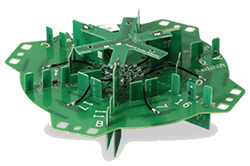Upgrade wireless network system
The common Wi-Fi network is not chosen by the enterprise (DN) as the main means of connection in the operation process due to some reasons for cost and coverage. The solution to wireless problems in businesses can be wireless network technology (Wireless Mesh Network).
Wi-Fi waves are not stable
Waves of Wi-Fi wireless networks - essentially radio waves, often weaken when the distance between the transmitter and the computer is far apart. Wi-Fi waves are also weak when encountering noise or obstructions. Usually Wi-Fi access devices are equipped with omni-directional antennas. These antennas are designed to transmit and receive waves from all directions and at all times. If an access point (AP) communicates with a user (user) at a specific location, the ambient noise sources will affect the transmission capability, thereby reducing the transmission rate as well as the Stability of connection.
 Figure 1.
Figure 1.
However, this wired network has certain shortcomings. The most obvious is that this system lacks the flexibility of the number of users and the location of the networked computer. Setting up more wired connections for new users will take time and effort of network administrators. In addition, in order to ensure aesthetic requirements, network cables are often sounded in the wall or under the floor, thereby leading to additional costs if there is a need to adjust or repair.
Increase network performance
For some special service groups such as education, health or tourism, establishing a wired network for all users is virtually impossible. Groups of users of these types of services often require flexible connections in terms of quantity and location at a high level. The solution to this problem is the wireless network Wireless Mesh Network , combined with the ability to regulate active connections based on orientation technology at each AP.
In the Wireless Mesh Network , the concept of ' orientation ' can be interpreted into two parts. That is to use an broadcast antenna that directs users to each AP, and uses groups of automatic APs to route together in the same network. The main purpose of this technology is to optimize the connectivity between the AP and user, as well as to establish the optimal wireless connection between APs, thereby reducing the number of APs needed and saving costs for Business
To navigate to the user, Smart APs (SmartAP) in the Wireless Mesh Network are structured to integrate the ' solid antenna ' system with various antenna elements, capable of combining into many forms. antenna patterns. These formats allow SmartAP to focus radio signals directly to each user, instead of spreading over a wide area like a traditional AP model. This is similar to focusing the flashlight's light into a stream of light compared to spreading the light of the light bulb. (See Figure 1 )
APs will collect the model all the way to the users with the performance and the initiative. After that, the AP will orient the optimal path and the antenna format used to connect to each user. If, for some reason, the transmission line is weakened, the system will automatically switch to a different line. Even if necessary, can actively change the AP for the user. In this way, the Wi-Fi network can determine ring path to avoid noise and ensure connection performance as well as stable coverage. (See Figure 2 )

Figure 2.
Flexible local area network
Also among APs in the Wireless Mesh Network system, the connection process is also done via Wi-Fi, completely without connecting cables. Therefore, there is almost no limit to terrain conditions such as how to connect with a normal cable, and only need to have a power supply. This model is very suitable for businesses in the tourism sector, or enterprises with large-scale offices.
By applying self-routing technology at APs, the Wireless Mesh Network system will be able to automatically set, optimize and fix errors. APs will continuously update the amount of information through throughput on a Root AP (the original AP) selected. When a faulty AP condition occurs, the entire network automatically adjusts the model to route traffic going through this error AP, continuing to maintain the stable connectivity of the entire network. (See Figure 3 )
The ability to manually redefine the connection model between APs also allows not only users in the coverage area to move, but APs can also switch locations. Therefore, if the company determines to establish a specific AP for a department, when moving or conducting a restructuring, there will be no need to modify, they just need to start the system and the AP will automatically determine re-optimal connection model

Figure 3.
The license now patents intelligent directional antenna arrays in AP and wave direction control software that is owned by Ruckus Wireless. Details at www.ruckuswireless.vn
 6 Wi-Fi utility tools for Windows
6 Wi-Fi utility tools for Windows How to join the domain in Windows 7
How to join the domain in Windows 7 Virtual network in Microsoft Hyper-V
Virtual network in Microsoft Hyper-V Learn about DHCP Server Security (part 2)
Learn about DHCP Server Security (part 2) Troubleshooting wireless networks
Troubleshooting wireless networks Remote computer management in Windows Server 2008 R2
Remote computer management in Windows Server 2008 R2